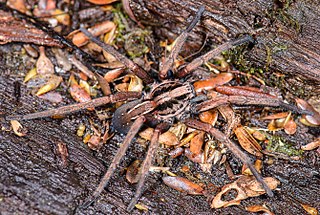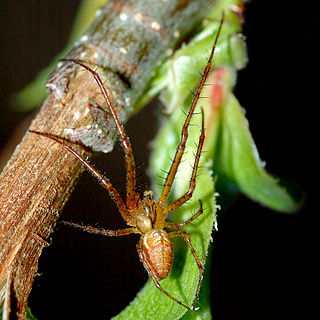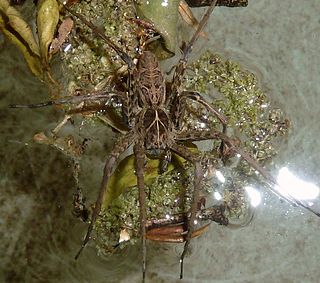
Huntsman spiders, members of the family Sparassidae, are known by this name because of their speed and mode of hunting. They are also called giant crab spiders because of their size and appearance. Larger species sometimes are referred to as wood spiders, because of their preference for woody places. In southern Africa the genus Palystes are known as rain spiders or lizard-eating spiders. Commonly they are confused with baboon spiders from the Mygalomorphae infraorder, which are not closely related.

Nursery web spiders (Pisauridae) is a family of araneomorph spiders first described by Eugène Simon in 1890. They resemble wolf spiders (Lycosidae) except for several key differences. Wolf spiders have two very prominent eyes in addition to the other six, while a nursery web spider's eyes are all about the same size. Additionally, female nursery web spiders carry their egg sacs with their jaws and pedipalps instead of attaching them to their spinnerets as wolf spiders do. When the eggs are about to hatch, a female spider builds a nursery "tent", places her egg sac inside, and stands guard outside, hence the family's common name. Like the wolf spiders, however, the nursery web spiders are roaming hunters that don't use webs for catching prey. They have a wide variety of prey, and larger species may prey upon vertebrates, particularly amphibians and fish.

Miturgidae is a family of araneomorph spiders that includes nearly 170 species in 29 genera worldwide. First described by Eugène Simon in 1886, it has been substantially revised, including of previous family "Zoridae" as subfamily "Zorinae" and excluding the family "Xenoctenidae". Several genera have also been removed, such as the large genus Cheiracanthium, which was transferred to the Cheiracanthiidae.

Long-jawed orb weavers or long jawed spiders (Tetragnathidae) is a family of araneomorph spiders first described by Anton Menge in 1866. They have elongated bodies, legs, and chelicerae, and build small orb webs with an open hub with few, wide-set radii and spirals with no signal line or retreat. Some species are often found in long vegetation near water.

Wandering spiders (Ctenidae) are a family of spiders that includes the Brazilian wandering spiders. These spiders have a distinctive longitudinal groove on the top-rear of their oval carapace similar to those of the Amaurobiidae. They are highly defensive and venomous nocturnal hunters. Despite their notoriety for being dangerous, only a few members of Phoneutria have venom known to be hazardous to humans, but the venoms of this family are poorly known, so all larger ctenids should be treated with caution.
Festucula is a genus of jumping spiders that was first described by Eugène Louis Simon in 1901.
Voraptus tenellus is a species of spider that is endemic to Mahe Island and Silhouette Island of Seychelles.
Anaxibia is a genus of cribellate araneomorph spiders in the family Dictynidae, and was first described by Tamerlan Thorell in 1898.

Hippasa is a genus of wolf spiders in the family Lycosidae, containing thirty five accepted species.
Stiphropus is a genus of crab spiders in the family Thomisidae, containing twenty species from Africa and Asia.
Brachyphaea is a genus of African corinnid sac spiders first described by W. Bösenberg & Heinrich Lenz in 1895.
Merenius is a genus of corinnid sac spiders first described by Eugène Simon in 1910.
Anchonastus is a genus of African huntsman spiders that was first described by Eugène Louis Simon in 1898.
Palpimanus is a genus of palp-footed spiders that was first described by L. Dufour in 1820.
Zenonina is a genus of spiders in the family Lycosidae. It was first described in 1898 by Simon. As of 2017, it contains 6 species.
Euprosthenops is a genus of nursery web spiders that was first described by Reginald Innes Pocock in 1897.
Maypacius is a genus of African nursery web spiders that was first described by Eugène Louis Simon in 1898.
Cydrela is a genus of spiders in the family Zodariidae. It was first described in 1873 by Thorell. As of 2017, it contains 19 species from a variety of places in Asia and Africa.

Cispius is a genus of African nursery web spiders that was first described by Eugène Louis Simon in 1898.






